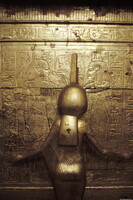Canopic Shrine
unknown (Egyptian (ancient)); Tutankhamen

Download7A3-EG-C-CM-2-C1_cp.jpg (668.7Kb)
Alternative Title
Shrine for Canopic Jars
Date
-1332--1322Description
Side with one of the four goddesses with open arms which watch over the canopic jars in the canopic shrine; Those organs regarded as essential for survival in the afterlife (liver, lungs, stomach and intestines) were removed from the body and separately embalmed. During most of the pharaonic period they were deposited in sets of four vases, known as canopic jars. These were then stored in chests or shrines. From the New Kingdom, a new type of canopic chest appeared-- the chests no longer directly imitated coffins but were made in the shape of a square shrine with a sloping lid and cavetto-cornice. They were mounted on sledge-runners and in depictions of the funeral procession they are shown being dragged to the tomb by this means. Tutankhamun's shrine stands some six and a half feet tall and is covered with gold and inlaid glass and decorative work. Facing inward on each of the four sides are small statues of the goddesses Neith, Nephthys, Isis, and Selkis. (Carter numbers 266 and 266A) Source: Grove Art Online; http://www.groveart.com/ (accessed 1/17/2008)
Type of Work
shrine (structure)Subject
death or burial, decorative arts, rulers and leaders, Egypt--Religion, Tutankhamen, King of Egypt, New Kingdom (Egyptian), Eighteenth Dynasty
Rights
Rights Statement
Licensed for educational and research use by the MIT community only